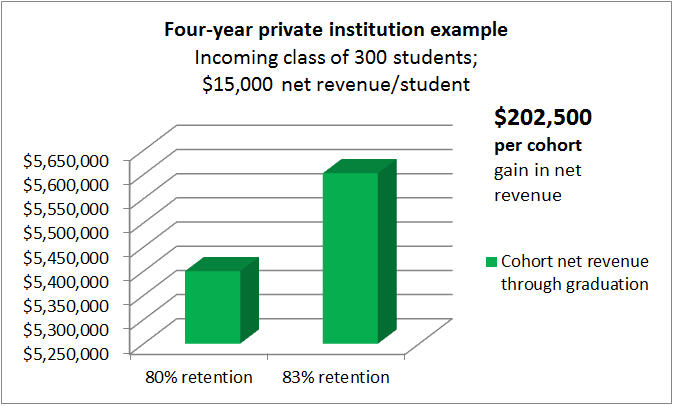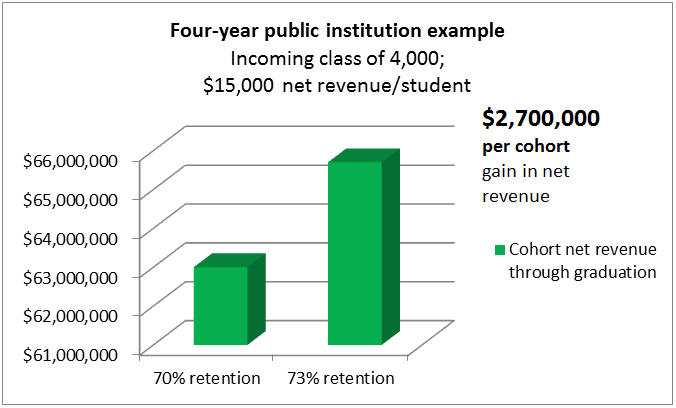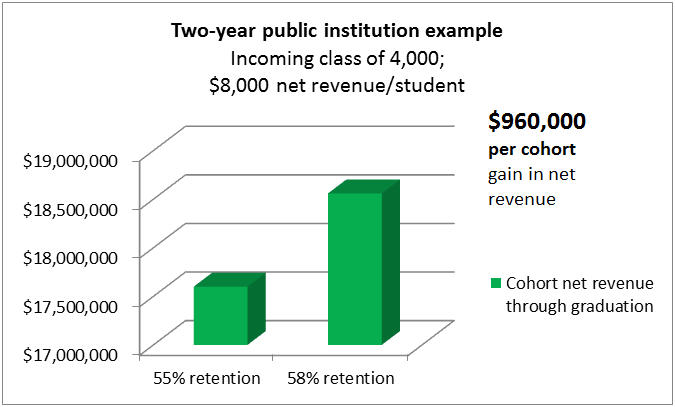student success
How does a 3 percent increase in college student retention add up financially?
Is your campus experiencing retention inertia? Do you struggle to find campuswide support and resources to meet your retention goals?
If you answered yes to either of these questions, I hope you can also say with all honesty that no one on your campus is grumbling about reduced funding or tighter budgets? Ah, I thought not. So what’s the connection?
Improving student retention, simply put, is one of the most dependable ways to generate millions of dollars in additional revenue at large institutions and hundreds of thousands of dollars even at very small institutions.
Examples: Estimated net revenue gains from a three percent increase in first-to-second-year retention
Consider the following three examples, each based on a three percent gain in retention:



How did we produce these examples? The math was fairly simple. For instance, in the first example, we calculated the number of additional second-year students that would be gained from the three percent increase in first-to-second-year retention (going from 80 percent retention to 83 percent):
80% retention rate: 300 incoming students X .80 = 240 students
83% retention rate: 300 incoming students X .83 = 249 students
This yielded a gain of nine students. We then multiplied the difference, nine, by the average net revenue per student ($15,000) and by a 1.5 retention factor to graduation. The examples for four-year public and two-year public follow the same formula.
Note: The examples do not take into consideration any changes in tuition or the costs of educating the additional students who persist. The revenue is not “net, net.” However, the marginal cost of educating each additional unit of enrollment is far less than the average cost of all enrollment units.
Share this with your Provost, CFO, and others to win support for additional retention initiatives this fall
The above estimates show that even modest improvements in retention make a big difference in revenue. We encourage you to share the examples with colleagues. Investing in retention programming is good business. Few, if any, other institutional investments will yield such a high return. Too often, increasing retention is not recognized as one of the most effective ways to add full-time equivalents, thereby broadening an institution’s revenue base.
In addition, retention improvements can happen relatively quickly. Noel-Levitz has helped campuses achieve an improvement of 3 to 5 percent in their retention rate within one year through aggressive strategy implementation.
Get a quick estimate of your institution’s student retention revenue with our auto-calculating worksheet
To quickly estimate retention revenue for your institution, use Noel-Levitz’s Retention Revenue Estimator. All you need to do is enter the number of additional second-year students you expect to gain (or “save”) and your average annual net revenue per student. If you don’t have the net revenue figure, ask your finance office to provide it.
For more help with accurately estimating retention revenue for your institution, or to discuss your retention strategy with a retention expert, we invite you to email or call us at 1-800-876-1117 for a complimentary consultation by phone.